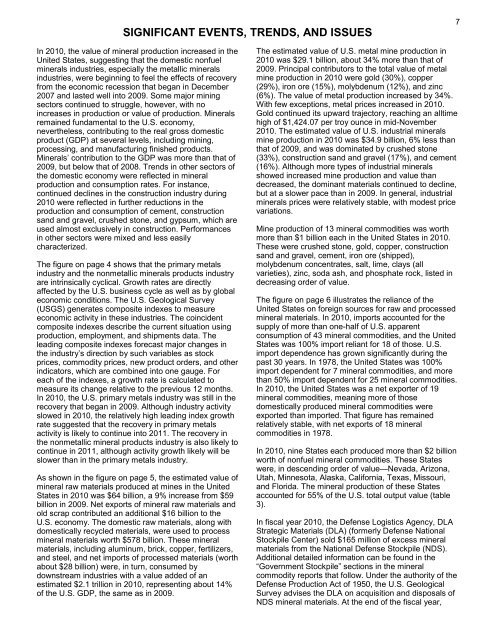SIGNIFICANT EVENTS, TRENDS, AND ISSUES7In 2010, the value of mineral production increased in theUnited States, suggesting that the domestic nonfuelminerals industries, especially the metallic mineralsindustries, were beginning to feel the effects of recoveryfrom the economic recession that began in December2007 <strong>and</strong> lasted well into 2009. Some major miningsectors continued to struggle, however, with noincreases in production or value of production. <strong>Mineral</strong>sremained fundamental to the U.S. economy,nevertheless, contributing to the real gross domesticproduct (GDP) at several levels, including mining,processing, <strong>and</strong> manufacturing finished products.<strong>Mineral</strong>s’ contribution to the GDP was more than that of2009, but below that of 2008. Trends in other sectors ofthe domestic economy were reflected in mineralproduction <strong>and</strong> consumption rates. For instance,continued declines in the construction industry during2010 were reflected in further reductions in theproduction <strong>and</strong> consumption of cement, constructions<strong>and</strong> <strong>and</strong> gravel, crushed stone, <strong>and</strong> gypsum, which areused almost exclusively in construction. Performancesin other sectors were mixed <strong>and</strong> less easilycharacterized.The figure on page 4 shows that the primary metalsindustry <strong>and</strong> the nonmetallic minerals products industryare intrinsically cyclical. Growth rates are directlyaffected by the U.S. business cycle as well as by globaleconomic conditions. The U.S. Geological Survey(USGS) generates composite indexes to measureeconomic activity in these industries. The coincidentcomposite indexes describe the current situation usingproduction, employment, <strong>and</strong> shipments data. Theleading composite indexes forecast major changes inthe industry’s direction by such variables as stockprices, commodity prices, new product orders, <strong>and</strong> otherindicators, which are combined into one gauge. Foreach of the indexes, a growth rate is calculated tomeasure its change relative to the previous 12 months.In 2010, the U.S. primary metals industry was still in therecovery that began in 2009. Although industry activityslowed in 2010, the relatively high leading index growthrate suggested that the recovery in primary metalsactivity is likely to continue into <strong>2011</strong>. The recovery inthe nonmetallic mineral products industry is also likely tocontinue in <strong>2011</strong>, although activity growth likely will beslower than in the primary metals industry.As shown in the figure on page 5, the estimated value ofmineral raw materials produced at mines in the UnitedStates in 2010 was $64 billion, a 9% increase from $59billion in 2009. Net exports of mineral raw materials <strong>and</strong>old scrap contributed an additional $16 billion to theU.S. economy. The domestic raw materials, along withdomestically recycled materials, were used to processmineral materials worth $578 billion. These mineralmaterials, including aluminum, brick, copper, fertilizers,<strong>and</strong> steel, <strong>and</strong> net imports of processed materials (worthabout $28 billion) were, in turn, consumed bydownstream industries with a value added of anestimated $2.1 trillion in 2010, representing about 14%of the U.S. GDP, the same as in 2009.The estimated value of U.S. metal mine production in2010 was $29.1 billion, about 34% more than that of2009. Principal contributors to the total value of metalmine production in 2010 were gold (30%), copper(29%), iron ore (15%), molybdenum (12%), <strong>and</strong> zinc(6%). The value of metal production increased by 34%.With few exceptions, metal prices increased in 2010.Gold continued its upward trajectory, reaching an alltimehigh of $1,424.07 per troy ounce in mid-November2010. The estimated value of U.S. industrial mineralsmine production in 2010 was $34.9 billion, 6% less thanthat of 2009, <strong>and</strong> was dominated by crushed stone(33%), construction s<strong>and</strong> <strong>and</strong> gravel (17%), <strong>and</strong> cement(16%). Although more types of industrial mineralsshowed increased mine production <strong>and</strong> value th<strong>and</strong>ecreased, the dominant materials continued to decline,but at a slower pace than in 2009. In general, industrialminerals prices were relatively stable, with modest pricevariations.Mine production of 13 mineral commodities was worthmore than $1 billion each in the United States in 2010.These were crushed stone, gold, copper, constructions<strong>and</strong> <strong>and</strong> gravel, cement, iron ore (shipped),molybdenum concentrates, salt, lime, clays (allvarieties), zinc, soda ash, <strong>and</strong> phosphate rock, listed indecreasing order of value.The figure on page 6 illustrates the reliance of theUnited States on foreign sources for raw <strong>and</strong> processedmineral materials. In 2010, imports accounted for thesupply of more than one-half of U.S. apparentconsumption of 43 mineral commodities, <strong>and</strong> the UnitedStates was 100% import reliant for 18 of those. U.S.import dependence has grown significantly during thepast 30 years. In 1978, the United States was 100%import dependent for 7 mineral commodities, <strong>and</strong> morethan 50% import dependent for 25 mineral commodities.In 2010, the United States was a net exporter of 19mineral commodities, meaning more of thosedomestically produced mineral commodities wereexported than imported. That figure has remainedrelatively stable, with net exports of 18 mineralcommodities in 1978.In 2010, nine States each produced more than $2 billionworth of nonfuel mineral commodities. These Stateswere, in descending order of value—Nevada, Arizona,Utah, Minnesota, Alaska, California, Texas, Missouri,<strong>and</strong> Florida. The mineral production of these Statesaccounted for 55% of the U.S. total output value (table3).In fiscal year 2010, the Defense Logistics Agency, DLAStrategic Materials (DLA) (formerly Defense NationalStockpile Center) sold $165 million of excess mineralmaterials from the National Defense Stockpile (NDS).Additional detailed information can be found in the“Government Stockpile” sections in the mineralcommodity reports that follow. Under the authority of theDefense Production Act of 1950, the U.S. GeologicalSurvey advises the DLA on acquisition <strong>and</strong> disposals ofNDS mineral materials. At the end of the fiscal year,
8TABLE 1.—U.S. MINERAL INDUSTRY TRENDS2006 2007 2008 2009 2010 eTotal mine production: 1Metals 23,100 25,200 27,200 21,800 29,100Industrial minerals 38,900 40,000 44,100 37,100 34,900Coal 29,300 29,600 36,600 35,600 36,300Employment: 2Coal mining 67 68 71 71 72Metal mining 25 28 32 28 29Industrial minerals, except fuels 82 82 79 73 71Chemicals <strong>and</strong> allied products 508 504 513 478 470Stone, clay, <strong>and</strong> glass products 391 384 363 305 294Primary metal industries 363 358 348 275 281Average weekly earnings of production workers: 3Coal mining 1,093 1,052 1,138 1,250 1,359Metal mining 974 1,074 1,195 1,096 1,161Industrial minerals, except fuels 861 870 838 807 843Chemicals <strong>and</strong> allied products 834 820 809 842 888Stone, clay, <strong>and</strong> glass products 712 716 711 706 726Primary metal industries 844 843 851 818 872e Estimated.1 Million dollars.2 Thous<strong>and</strong>s of production workers.3 Dollars.Sources: U.S. Geological Survey, U.S. Department of <strong>Energy</strong>, U.S. Department of Labor.TABLE 2.—U.S. MINERAL-RELATED ECONOMIC TRENDSGross domestic product (billion dollars)2006 2007 2008 2009 2010 e13,399 14,062 14,369 14,119 14,600Industrial production (2007=100):Total index 97 100 97 88 93Manufacturing: 97 100 96 85 90Nonmetallic mineral products 101 100 89 74 75Primary metals: 98 100 98 67 85Iron <strong>and</strong> steel 98 100 104 62 91Aluminum 106 100 93 72 75Nonferrous metals (except aluminum) 85 100 100 88 89Chemicals 95 100 94 91 94Mining: 99 100 101 96 101Coal 102 100 102 94 94Oil <strong>and</strong> gas extraction 98 100 101 106 110Metals 102 100 104 90 99Nonmetallic minerals 108 100 87 71 73Capacity utilization (percent):Total industry: 81 81 78 70 74Mining: 90 89 89 82 86Metals 80 78 81 70 78Nonmetallic minerals 88 83 74 65 69Housing starts (thous<strong>and</strong>s) 1,810 1,340 900 554 588Light vehicle sales (thous<strong>and</strong>s) 1 12,700 12,200 9,720 7,520 8,590Highway construction, value, put in place (billion dollars) 72 77 81 82 82e Estimated.1 Excludes imports.Sources: U.S. Department of Commerce, Federal Reserve Board, Autodata Corp., <strong>and</strong> U.S. Department of Transportation.
- Page 3: U.S. Department of the InteriorKEN
- Page 6 and 7: INTRODUCTION3Each chapter of the 20
- Page 8 and 9: 5NET EXPORTS OF MINERALRAW MATERIAL
- Page 12 and 13: mineral materials valued at $1.30 b
- Page 14 and 15: 11MAJOR METAL-PRODUCING AREASAuB2P1
- Page 16 and 17: 13MAJOR INDUSTRIAL MINERAL-PRODUCIN
- Page 18 and 19: ABRASIVES (MANUFACTURED)15Events, T
- Page 20 and 21: ALUMINUM17The United States continu
- Page 22 and 23: ANTIMONY19Events, Trends, and Issue
- Page 24 and 25: ARSENIC21According to university me
- Page 26 and 27: ASBESTOS23Events, Trends, and Issue
- Page 28 and 29: BARITE25Nationally, the rig count o
- Page 30 and 31: BAUXITE AND ALUMINA27Events, Trends
- Page 32 and 33: BERYLLIUM29Events, Trends, and Issu
- Page 34 and 35: BISMUTH31Events, Trends, and Issues
- Page 36 and 37: BORON33Events, Trends, and Issues:
- Page 38 and 39: BROMINE35Events, Trends, and Issues
- Page 40 and 41: CADMIUM37NiCd battery use in consum
- Page 42 and 43: CEMENT39The manufacture of clinker
- Page 44 and 45: CESIUM41Events, Trends, and Issues:
- Page 46 and 47: CHROMIUM43Stockpile Status—9-30-1
- Page 48 and 49: CLAYS45Tariff: Item Number Normal T
- Page 50 and 51: COBALT47Events, Trends, and Issues:
- Page 52 and 53: COPPER49Events, Trends, and Issues:
- Page 54 and 55: DIAMOND (INDUSTRIAL)51Events, Trend
- Page 56 and 57: DIATOMITE53Events, Trends, and Issu
- Page 58 and 59: FELDSPAR55Feldspar use in tile and
- Page 60 and 61:
FLUORSPAR57with planned output of 1
- Page 62 and 63:
GALLIUM59In response to the unprece
- Page 64 and 65:
GARNET (INDUSTRIAL)61Events, Trends
- Page 66 and 67:
GEMSTONES63Events, Trends, and Issu
- Page 68 and 69:
GERMANIUM65Events, Trends, and Issu
- Page 70 and 71:
GOLD67With the increase in price of
- Page 72 and 73:
GRAPHITE (NATURAL)69Events, Trends,
- Page 74 and 75:
GYPSUM71Through 2010, more than 3,6
- Page 76 and 77:
HELIUM73Events, Trends, and Issues:
- Page 78 and 79:
INDIUM75China’s 21 indium produce
- Page 80 and 81:
IODINE77Events, Trends, and Issues:
- Page 82 and 83:
IRON AND STEEL79Events, Trends, and
- Page 84 and 85:
IRON AND STEEL SCRAP81Tariff: Item
- Page 86 and 87:
IRON AND STEEL SLAG83Events, Trends
- Page 88 and 89:
IRON ORE85In 2009, China imported a
- Page 90 and 91:
IRON OXIDE PIGMENTS87Events, Trends
- Page 92 and 93:
KYANITE AND RELATED MATERIALS89Even
- Page 94 and 95:
LEAD91caused by underground fires a
- Page 96 and 97:
LIME93The lime industry is facing p
- Page 98 and 99:
LITHIUM95market, and a facility at
- Page 100 and 101:
MAGNESIUM COMPOUNDS97In Australia,
- Page 102 and 103:
MAGNESIUM METAL99U.S. magnesium con
- Page 104 and 105:
MANGANESE101Government Stockpile:St
- Page 106 and 107:
MERCURY103Events, Trends, and Issue
- Page 108 and 109:
MICA (NATURAL)105Depletion Allowanc
- Page 110 and 111:
MOLYBDENUM107Events, Trends, and Is
- Page 112 and 113:
NICKEL109Nickel prices were adverse
- Page 114 and 115:
NIOBIUM (COLUMBIUM)111Events, Trend
- Page 116 and 117:
NITROGEN (FIXED)—AMMONIA113Accord
- Page 118 and 119:
PEAT115Events, Trends, and Issues:
- Page 120 and 121:
PERLITE117Events, Trends, and Issue
- Page 122 and 123:
PHOSPHATE ROCK119Events, Trends, an
- Page 124 and 125:
PLATINUM-GROUP METALS121Events, Tre
- Page 126 and 127:
POTASH123Events, Trends, and Issues
- Page 128 and 129:
PUMICE AND PUMICITE125Events, Trend
- Page 130 and 131:
QUARTZ CRYSTAL (INDUSTRIAL)127Event
- Page 132 and 133:
RARE EARTHS129Events, Trends, and I
- Page 134 and 135:
RHENIUM131Events, Trends, and Issue
- Page 136 and 137:
RUBIDIUM133Events, Trends, and Issu
- Page 138 and 139:
SALT135Many chefs have advocated us
- Page 140 and 141:
SAND AND GRAVEL (CONSTRUCTION)137Ev
- Page 142 and 143:
SAND AND GRAVEL (INDUSTRIAL)139The
- Page 144 and 145:
SCANDIUM141Scandium’s use in meta
- Page 146 and 147:
SELENIUM143Events, Trends, and Issu
- Page 148 and 149:
SILICON145Events, Trends, and Issue
- Page 150 and 151:
SILVER147Silver was used as a repla
- Page 152 and 153:
SODA ASH149A Wyoming soda ash produ
- Page 154 and 155:
SODIUM SULFATE151Events, Trends, an
- Page 156 and 157:
STONE (CRUSHED)153Events, Trends, a
- Page 158 and 159:
STONE (DIMENSION)155Events, Trends,
- Page 160 and 161:
STRONTIUM157Events, Trends, and Iss
- Page 162 and 163:
SULFUR159World sulfur production in
- Page 164 and 165:
TALC AND PYROPHYLLITE161Events, Tre
- Page 166 and 167:
TANTALUM163Events, Trends, and Issu
- Page 168 and 169:
TELLURIUM165Events, Trends, and Iss
- Page 170:
THALLIUM167Beginning in 2009, there
- Page 173 and 174:
170TIN(Data in metric tons of tin c
- Page 175 and 176:
172TITANIUM AND TITANIUM DIOXIDE 1(
- Page 177 and 178:
174TITANIUM MINERAL CONCENTRATES 1(
- Page 179 and 180:
176TUNGSTEN(Data in metric tons of
- Page 181 and 182:
178VANADIUM(Data in metric tons of
- Page 183 and 184:
180VERMICULITE(Data in thousand met
- Page 185 and 186:
182WOLLASTONITE(Data in metric tons
- Page 187 and 188:
184YTTRIUM 1(Data in metric tons of
- Page 189 and 190:
186ZEOLITES (NATURAL)(Data in metri
- Page 191 and 192:
188ZINC(Data in thousand metric ton
- Page 193 and 194:
190ZIRCONIUM AND HAFNIUM(Data in me
- Page 195 and 196:
192APPENDIX AAbbreviations and Unit
- Page 197 and 198:
194Demonstrated.—A term for the s
- Page 199 and 200:
196Part B—Sources of Reserves Dat
- Page 201:
198Europe and Central Eurasia—con







